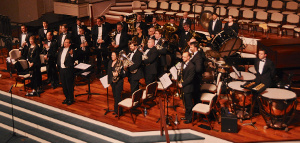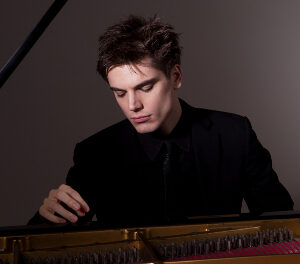Fortieth birthday parties are often draped in black crepe and balloons, jokingly signifying the end of the honoree’s life as they know it, or, at least an introduction to the need for life support. Not so for the Salisbury Symphony celebrating its fortieth anniversary with a grand celebration in Keppel Auditorium at Catawba College. Instead of the groans and wheezes of a moribund patient, the Salisbury Symphony, is just now entering its prime, and it pulled out all the stops, bells, and whistles, and about 70 other instruments, for this, the final concert of the 40th season. There’s nothing sick or weak about this group!
Music Director David Hagy programmed at least one work that had been played during each four-year period of the orchestra’s history. Joining Hagy on stage during the concert were guest and founding conductor Albert Chaffoo, Salisbury Youth Orchestra conductor Ryan Peller, the Rowan County Fifth Grade Honors Chorus, and the Salisbury Youth Orchestra.
The Salisbury Symphony was founded in 1967 as the result of an inspiration of Dr. Samuel E. Duncan, then president of Livingston College, in collaboration with Catawba College president Dr. Donald C. Dearborn. Dr. Albert Chafoo, who was conducting the orchestra in Hickory, NC, was hired to organize the orchestra and teach at both colleges as well as in the Salisbury City School System. The first concert took place on November 6, 1967.
The program opened with Dr. Chafoo conducting the very first piece that the orchestra played at the first concert, “The Star Spangled Banner.” He then went on to conduct the closing work of that same concert, “Triumphal March” from Sigurd Jorsalfar by Edvard Grieg (1843-1907).
When he steps on the podium, Dr. Chafoo, although now physically frail, retains the vigor and precision of a much younger man and draws from the orchestra grand and sweeping phrases and great dynamic shifts from very soft to very loud. I can only wonder what he thinks of his “baby” now.
Maestro Hagy then took over the podium to conduct the fourth movement of the Symphony No. 2 by Ludwig van Beethoven (1770-1827). This was followed by the opening movement of Symphony No. 1 by Dmitri Shostakovich (1906-75), never before played by the Salisbury Symphony, but played by the North Carolina Symphony as part of the twelfth season in 1978. (Each year, the North Carolina Symphony plays one concert as part of the Salisbury season.)
There followed audience favorites “On the Beautiful Blue Danube” by Johann Strauss, Jr. (1825-99), “Fiddle-Faddle” by Leroy Anderson (1908-75), and “Bacchanal” from Samson and Delilah by Camille Saint-Saëns (1835-1921).
Following intermission, David Hagy conducted the Overture to Candide by Leonard Bernstein (1918-90). The maestro was attached to a spring contraption on his feet, à la Cirque du Soleil, which allowed him to twist, lean, and bend in all sorts of wild directions without falling over, much to the delight of the audience.
As a tribute to Livingstone College’s heritage, the orchestra then played “Lyric for Strings” by George Walker (b.1922). This was followed by a selection from Pulcinella (“Ballet with Song”) by Igor Stravinsky (1882-1971).
The Salisbury Youth Orchestra and the All-County Fifth Grade Honors Chorus then joined the Salisbury Symphony for a presentation of “A Whole New World” from the motion picture Aladdin by Alan Menken (b.1949). This was co-conducted by Ryan Peller. The Fifth Grade Honors Chorus then reprised the first song it ever sang with the Salisbury Symphony fifteen years ago, “Let There Be Peace on Earth” by Sy Miller and Jill Jackson and arranged by Hawley Ades (b.1908). It would be interesting to know if any of the members of that original chorus, now young adults, were present in the audience.
The program closed with Carmen Dragon’s (1914-84) arrangement of “America, the Beautiful” by Samuel Ward (1848-1903). Following riotous applause, the orchestra treated the audience to an encore of “Turkey in the Straw.”
This concert featured all of the section principal players in various solo parts, and each shone during his or her turn in the spotlight.
I have missed few of the Salisbury Symphony’s concerts during the past twenty years, and I have witnessed tremendous growth in the depth and breadth of their playing. They are now at the top of their game. Although this concert was technically a “pops” concert, the program was not an easy one to play and the playing was topnotch — some of the best I have heard from this ensemble. The superb performance was also noted by a very appreciative and what appeared to be a record-sized audience.













